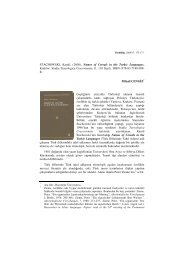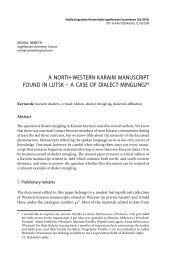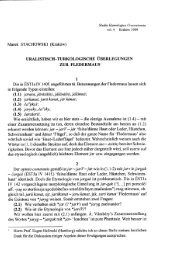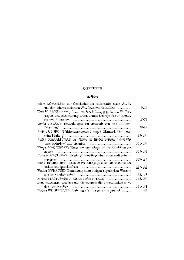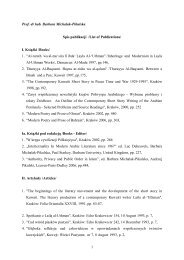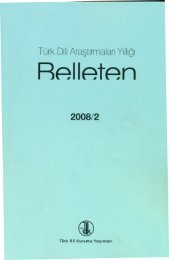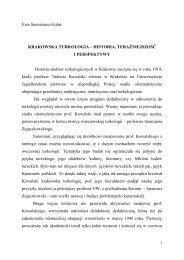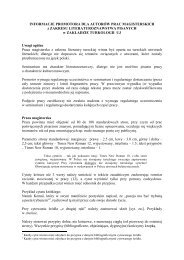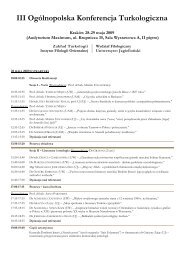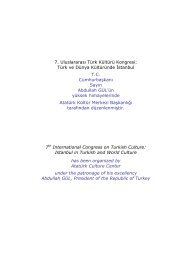Names of Cereals in the Turkic Languages - Wydział Filologiczny UJ
Names of Cereals in the Turkic Languages - Wydział Filologiczny UJ
Names of Cereals in the Turkic Languages - Wydział Filologiczny UJ
- No tags were found...
Create successful ePaper yourself
Turn your PDF publications into a flip-book with our unique Google optimized e-Paper software.
44 taragan || Millettaraganforms:taragan Kmnd.: Eren 1999 || Oyr.: R III 840b || Tel.: R III 840b, Eren 1999taran Brb.: R III 841m, ÈSTJa, KWb 380tarān Oyr.: RAltS, Dmitrieva 1972, Brands 1973: 33, ÈSTJa, KWb 380, Eren 1999 || Tel.:R III 841m, ÈSTJa, KWb 380, Eren 1999 || Yak. Fedotov 1996 ~ üöre ‘millet; groats’languages:Brb.: taran || Kmnd.: taragan || Oyr.: taragan, tarān || Tel.: taragan, tarān || Yak.: tarānetymology:1935: KWb 380: Brb. tarian, Oyr., Tel. tarān < Mo.1960: VGAS: Mo. tarijan ‘field; sow<strong>in</strong>g’, tarijad ‘sow<strong>in</strong>g; cereal’ &c. = OTkc. taryg‘crop; cereal’1973: Brands: 33: < Mo. tarijan, tarān ‘sow<strong>in</strong>g; cereal’1974: ÈSTJa: < tar-a-; aga<strong>in</strong>st deriv<strong>in</strong>g < Mo. tarija(n)1999: Eren: < Mo.commentary:ÈSTJa is aga<strong>in</strong>st KWb 380 for phonetic reasons (Mo. -ija : Tkc. -aγa-), and supportsVGAS 62 assum<strong>in</strong>g a parallel evolution tar-a- + -gan > Tkc. taragan &c., Mo. tarija.We too, support this conception. Cf. dary, -tarā.tögüforms:tögi MTkc.MK: (Oghuz.) Eren 1999 ‘husked millet’tögü OTkc.: TMEN 979, ÈSTJatöhö OTkc.: ÈSTJatügä OTkc.: VEWT ‘husked yellow millet’tügi Čag.: ‘husked millet’ TMEN 979 || MTkc.: VEWT ‘husked millet’ || MTkc.MK:Dank<strong>of</strong>f/Kelly 1982–85 || Uyg.: VEWT ‘husked millet’tügü MTkc.KD: تكو ‘husked millet’tui Trkm.: طوی ,توی R III 1423btüi Krč.: Pröhle 1909, VEWTlanguages:Čag.: tügi || Krč.: tüi || MTkc.: tügi || MTkc.KD: tügü || MTkc.MK: tögi, tügi || OTkc.:tögü, töhö, tügä || Trkm.: tui || Uyg.: tügietymology: see tüvi ‘rice’commentary:See tüvi ‘rice’; also dövme ‘wheat’.Trkm. tui ,توی) ,طوی so tüvi and tuvi can not be excluded ei<strong>the</strong>r; cf. Trkm. tüvi ‘rice’)is most probably, as suggested by TMEN 979. borrowed from Čag. or ano<strong>the</strong>r Kipč.source, as is <strong>in</strong>dicated by <strong>the</strong> voiceless auslaut (cf. also dary).



